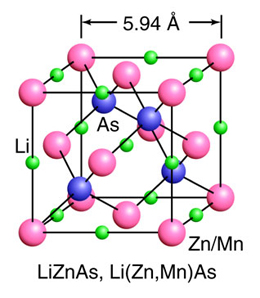Research Abstract
I–II–V族半導体をベースとした新世代の磁性半導体Li(Zn,Mn)As
III–V族半導体をベースとした典型的な磁性半導体(Ga,Mn)Asでは、3価のGaサイトが2価のMnイオンによって置換されるため、化学的安定条件が厳しく制限され、準安定試料は薄膜でしか得られない。
Li(Zn,Mn)As as a new generation ferromagnet based on a I–II–V semiconductor
2011年8月9日 Nature Communications 2 : 422 doi: 10.1038/ncomms1425

III–V族半導体をベースとした典型的な磁性半導体(Ga,Mn)Asでは、3価のGaサイトが2価のMnイオンによって置換されるため、化学的安定条件が厳しく制限され、準安定試料は薄膜でしか得られない。さらに、GaをMnで置換するために正孔キャリアのドーピングが同時に行われ、電子ドーピングを行うことができない。このような問題を克服するため、Masekたちは、I–II–V族半導体LiZnAsをベースとした系を理論的に提案した。この系では、等原子価のZnとMnを置換することで磁性が導入される。また、Liの濃度により正孔/電子の両方のドーピングが可能になる。今回我々は、バルク材料のLi1+y(Zn1−xMnx)Asの合成に成功したことを報告する。p型金属キャリアを持つ、Mn濃度x = 0.02~0.15のわずかにLi過剰な(y = 0.05~0.2)化合物において、臨界温度が最高50 Kの強磁性が観察されている。これは、おそらくZnサイトが過剰のLiにより置換されることに起因する。半導体のLiZnAs系、強磁性体のLi(Zn,Mn)As系、反強磁性体のLiMnAs系、超伝導体のLiFeAs系は、ともに正方格子のAs層を共有しているため、これらを組み合わせて新しい接合デバイスやp–n接合を将来開発できる可能性がある。
- 中国科学院
- コロンビア大学(米国)
- 浙江大学(中国)
- 清華大学(中国)
- マックマスター大学(カナダ)
- 東京大学大学院理学系研究科
- 独立行政法人 日本原子力研究開発機構
- 独立行政法人 科学技術振興機構
- 国立素粒子原子核物理学研究所(カナダ)
In a prototypical ferromagnet (Ga,Mn)As based on a III–V semiconductor, substitution of divalent Mn atoms into trivalent Ga sites leads to severely limited chemical solubility and metastable specimens available only as thin films. The doping of hole carriers via (Ga,Mn) substitution also prohibits electron doping. To overcome these difficulties, Masek et al. theoretically proposed systems based on a I–II–V semiconductor LiZnAs, where isovalent (Zn,Mn) substitution is decoupled from carrier doping with excess/deficient Li concentrations. Here we show successful synthesis of Li1+y(Zn1−xMnx)As in bulk materials. Ferromagnetism with a critical temperature of up to 50 K is observed in nominally Li-excess (y = 0.05–0.2) compounds with Mn concentrations of x = 0.02–0.15, which have p-type metallic carriers. This is presumably due to excess Li in substitutional Zn sites. Semiconducting LiZnAs, ferromagnetic Li(Zn,Mn)As, antiferromagnetic LiMnAs, and superconducting LiFeAs systems share square lattice As layers, which may enable development of novel junction devices in the future.

